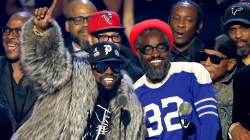“To all you artists out there, who don’t wanna be on a record label where the executive producer’s…all up in the videos, all on the records, dancin’…then come to Death Row!” -Suge Knight, 1995 Source Awards.
Back in 1995, when Suge Knight made those not so subliminal references to Sean Combs, he was also pointing out a change taking place within the music business. In his mind, Suge represented the classic record executive. While some of his tactics may have differed from the classic record executive, like most of his peers who came before him, he handled the business end of things, and for the most part, played the background. Knight was in the music business, but he didn’t make music. Puff was different. Even before No Way Out dropped in July of 1997, he was already an entertainer. Besides the remixes he received production credit for, and his roles as executive producer, Combs already had guest verses as early as ’93 (Supercat’s remix to “Dolly My Baby”). Combs, along with the likes of Jermaine Dupri were record execs who also played the role of artists, showing future emcees like Jay Z that they too could play on both sides of the field. However, while Combs receives a lot of credit for his role as an executive and artist, before Puffy, Dupri, or Jay Z, there was Eazy-E.
There’s a solid argument to be made that 1988 was the best year in Hip Hop’s history. Many emcees who would go on to become legends released some of their best work, whether it be Big Daddy Kane’s Long Live the Kane, Slick Rick’s The Great Adventures of Slick Rick, Run DMC’s Tougher Than Leather, Public Enemy’s It Takes a Nation of Millions to Hold Us Back, EPMD’s Strictly Business, Eric B. & Rakim’s Follow the Leader, or Boogie Down Productions’ By All Means Necessary; the East’s dominance was definitely in full effect. While the West was finding its voice with releases like of Ice T’s Power, Too Short’s LIfe is…Too Short and King Tee’s Act a Fool, one upstart imprint released three major releases in rapid succession. While Ruthless Records is often credited with N.W.A’s Straight Outta Compton and Eazy-E’s Eazy-Duz-It, what most don’t realize is Ruthless was also responsible for J.J. Fad’s Supersonic-The Album.
We Want Eazy: The Origins Of Ruthless Records
“We first were on Dream Team records with Rudy Pardee,” says Juana Sperling, known as MC J.B., one third of J.J. Fad. “[Rudy] was friends with Eric, and he was like, ‘Hey man, I want you to listen to this.’ Eric was like, ‘Man, I gotta have them girls. How much do you want for them?’ Eric thought he could do more for us, so we got out of that contract. [Pardee] and Eazy worked it out. We went on with Ruthless, and that’s when we blew up. Eric had the business sense and savvy. We remixed the whole thing, and that’s when it took off.” Produced by Dr. Dre, DJ Yella, and Arabian Prince before the release of Straight Outta Compton, and executed and produced by Eazy-E, Supersonic-The Album went on to go platinum (including the single of the same name), going gold before Straight Outta Compton was released. J.J. Fad and Salt-N-Pepa shared the distinction of being the first female Rap groups nominated for a Grammy.
While Eazy-E may or may not have been the first Rap artist to lead an imprint, he was definitely one of the first to lead a successful one with successful artists other than himself or his crew. To let Jerry Heller tell it, per his book, Ruthless: A Memoir, Ruthless Records unofficially started March 3, 1987 with a meeting between Heller and a young, aspiring businessman named Eric Wright, who paid $750 just to meet Heller. While Eazy-E already existed, a young Eric Wright didn’t initially have musical aspirations. Per DJ Yella, Eazy wasn’t exactly enthusiastic to lay down vocals for the song that eventually became “Boyz-N-The Hood” (which was recorded before Ruthless existed).
“Well, “Boyz-N-The-Hood” was meant for another group—a New York group,” DJ Yella revealed in a recent interview with HipHopDX. “It wasn’t meant for Eazy to do the song. But the other guys didn’t wanna do the song, because they were from the East Coast, so they didn’t think it was their style or whatever their reasons were. And that’s how Dre convinced E to do the song, because E wasn’t a rapper…he wasn’t a rapper at all. It’d take him all day to do lyrics. That was the hardest thing: to get him into the studio to do them. And when he finally got there, it would take all day.”
Just Tah Let U Know: Eazy-E’s Diverse And Successful Roster
Google search “Godfather of Gangster Rap” and most results point directly to Eazy-E; however, under Eazy’s watch, Ruthless Records wasn’t just in the “Gangster Rap” business. While 1988 saw them release the aforementioned J.J. Fad album to commercial success along with Straight Outta Compton (which shipped gold), and Eazy’s own Eazy-Duz-It (which is double platinum), 1989 saw the label release Michel’le’s self titled album. Behind singles like “No More Lies,” “Something in My Heart,” and “Nicety” Michel’le would also go platinum. Ruthless was stockpiling talent. While J.J. Fad, N.W.A, The D.O.C., and Michel’le were on the charts, artists who would go on to later make an impact elsewhere were also connected to the label.
“Back in the day, when Eazy and them were starting N.W.A…I had no part in the NWA situation,” Sir Jinx explained to HipHopDX. “Me and Eazy had a relationship. I was trying to get Eazy to let me have my own…I would say, department.” Jinx, known for his work on Ice Cube’s early solo work, and helping Xzibit on 40 Days and 40 Nights, was originally in a group C.I.A. (Cru in Action), with Ice Cube and K-Dee before Cube joined N.W.A. “It wasn’t like my label, and I wouldn’t even think of that. I was like, ‘Let me have my own leg of the Ruthless family. I been here since day one.’ [Eazy E] was like, ‘Alright.’ My groups I took over there was Yo-Yo and Del [Tha Funkee Homosapien]. Del had two young guys with him. They were like 14, and 15. Those two guys were [Souls of Mischief Members] Tajai and Adam [A-Plus].” As it turns out, Eazy was diversifying. He later signed Blood of Abraham, and he gave another commercially successful group of Los Angeles-based musicians their first shot.
“I hear now that he had will.i.am at one time,” MC Ren recalled in a conversation about Eazy. “Atban Klann? I used to see that name on shirts and Ruthless stuff, but I didn’t know who that was. It’s a trip how he knew how to find people. It was a gift he had.”
While Eazy was great at evaluating and signing talent, he never slacked on the business end, either. Originally, Eazy’s music was released through a small independent label, Macola. Transitioning his Ruthless artists to Priority, Eazy was taking no shorts or losses.
“Going from [Macola] to Priority wasn’t much different, because E made a deal as a distributor not as being signed to the record label,” DJ Yella informed HipHopDX in an interview. “That’s what he held out for. He wanted his label to be on the records—Ruthless on them with Priority at the bottom.”
Eazy-Duz-It: The Vision Behind Ruthless Records
Nothing stopped Eazy from handling his business.
“When he signed to Priority, we’d be sitting in meetings with Brian Turner and all these other white dudes,” MC Ren recalled, “Eric’s son Derrick had just been born. He’d be in there…son shit in the diaper, and have the whole business meeting office shitty…stanking up. Eric would be in there talking business, changing shitty diapers. The people in the meeting try to act like the smell ain’t stinking ‘cause they all about that business. E was following through on that vision.”
Ren, originally signed to Ruthless as a solo artist, appeared on the cover of N.W.A’s N.W.A. and the Posse independent debut in 1987, but didn’t appear on record until Ruthless’ 1988 records.
“He saw something we didn’t see,” Ren added. “He saw that shit. He saw the potential of Ruthless Records. When he was doing interviews, people would ask [Eazy] about N.W.A—this was before Straight Outta Compton—after the first couple singles. He’d sit there with a straight face and say, ‘N.W.A is an all-star group.’ I’d be like, ‘Dude, we ain’t did nothin’ yet.’ He’d be saying that shit so confident. I could tell interviewers were looking at him like, ‘All-star group? Y’all ain’t did nothin’. Then, bam!’ Shit started blowing up.”
Per Ren, the recording environment at Ruthless was one of complete freedom.
“He let you do whatever you wanted to do,” Ren said. “He didn’t put no restrictions on you. I could have did a record repeating the same word over and over again, and he wouldn’t have said nothing. He just would have put it out.” J.J. Fad member Juana Sperling shared a similar recollection, saying, “He was there every single time were in the studio. If he didn’t like it, he let us know. If he loved it, he let us know. I don’t think there was ever a time in the studio he wasn’t there. We knew he was our executive producer. We knew he was in charge, but it wasn’t like a boss type relationship, it was more like a family. He was there supporting us. He let us do whatever we thought was best. In turn, we turned a lot over to him and Dre and let them guide us, ‘cause were were new in the game. There’s a lot of stuff we thought was cool that was corny…so we kind of let them guide us. They let us have freedom if we wanted to do pop, if we wanted to do Hip Hop. They guided us with what they thought would be in the best interest of our career.”
Impact Of A Legend: Eazy-E’s Enduring Legacy
But of course, Ruthless’ reign hit a speed bump. N.W.A fell apart. Dr. Dre left, taking some artists with him. While the label appeared to take a hit, Eazy made sure Ruthless stayed relevant. Among its post N.W.A successes, 5150 Home For Tha Sick (1992) is certified gold, and “Real Muthaphuckkin G’s” (1993) a shot at former N.W.A member Dr. Dre, was #42 on Billboard magazine’s “Hot 100” and stayed on the charts for 16 weeks. Yet, it was a signing in late 1993 that would change everything.
“Somehow we got the number to Eazy-E’s office, and we just kept calling and calling until one day the secretary was like, ‘I’m going to make sure he calls you back, ‘cause I’m tired of y’all calling in,’” Krayzie Bone relayed to HipHopDX in a past interview. “‘Y’all been calling every day, and I’ll make sure he call you back.’ So, one day he called us back, and I rapped for him on the phone, and it was just crazy. He was just trippin. He said that he had a show coming up in Cleveland in two weeks, so we was like, ‘Man, we gotta hustle up and get down to that show.’ So we hustled up some more money just to get tickets back to Cleveland and met him at the show. Once he found out it was us who rapped on the phone, he was like, ‘When y’all trying to leave?’ And two days later, we was back on our way to Los Angeles—this time with Eazy-E paying for it though. So, it was crazy.” Eazy signed Bone Thugs-N-Harmony backstage at that show.
While Eazy gave his artists creative freedom on their projects, he was still very much involved in their development. The signing of Cleveland-based group Bone Thugs-N-Harmony not only kept Ruthless Records culturally relevant, but it also provided the type of commercial boost necessary to keep all record labels in business.
“It was definitely a privilege and a pleasure to be in the presence of Eazy-E along with having him executive producing and marketing that record,” Flesh-N-Bone told DX in regards to Eazy’s involvement in Creepin On Ah Come Up. “We watched how he marketed that record from grassroots-type marketing, and he taught us the advantage of going to the mom and pop stores, feeling good about pulling up in the neighborhood and passing out a flyer or a couple of CDs. Eazy-E did a lot of the photo shooting himself; he did a lot of the video shooting himself. He taught us the necessity of how to prepare a record and how to get it out there. He took us to the public relation office and to the radio stations to meet the program directors and stuff of that nature. We carry all of that knowledge with us today.” While Eazy was very much involved in the creation of Bone’s debut major retail release, he passed during the creation of their sophomore album, E. 1999 Eternal. Using what their mentor taught them, as well as paying homage to him with the hit single “Crossroads,” E. 1999 Eternal would be Bone’s most successful album, selling over four million copies. “Crossroads” gave the Cleveland collective a #1 single and added a Grammy win to Ruthless Records’ long list of achievements.
Eazy-E’s success as an artist and executive are undeniable; yet, often, he’s not credited nearly enough. Opinions vary on exactly why this is. Some feel the success of Dr. Dre overshadows a lot of the accomplishments by other West Coast artists. Protracted feuds with former N.W.A members Ice Cube and Dr. Dre didn’t help Eazy’s public perception, despite his claims that he still profited from certain Death Row Records releases. With Eazy specifically, the most popular sentiment is that his cause of death prevents the pioneer from getting his just due.
“If he would have gotten shot 12 times, he would have been a hero,” Layzie Bone told the Los Angeles Times. “But because he died of HIV and full-blown AIDS, people weren’t really ready to face that in 1995. Nobody wanted to look at the reality that sex was killing people.”
An overabundance of boutique Rap labels and joint ventures during the ‘90s through the mid-2000s diminished the perception of what a fully functional record label actually does. For example, 17-year-old Chief Keef’s 2013 deal with Interscope allegedly included a separate $440,000 advance and an additional $200,000 to cover overhead expenses for his Glory Boyz Entertainment imprint. Per MTV, Interscope has the option of terminating the deal if GBE incurs losses greater than $4.5 million. In contrast, the Ruthless track record of multiple hit singles, gold and platinum (or better) albums and Grammy nods would be impressive for a label launched today—let alone one launched in 1987. Few labels, if any can hold a torch to what Eazy-E did with Ruthless in terms of the creative freedom offered, the mentorship provided, and the success achieved. Regardless of how he passed, what he accomplished in his life, which was unfortunately cut far too short, should be celebrated year-round throughout Hip Hop. This holds true not just in the West, where Eazy rose to fame at a time in which it was hard enough just being an artist, but from all over.
“If it wasn’t for Eric a lot of these people wouldn’t even be who they are in a business sense from 50 Cent to Dr. Dre to Master P,” fellow Compton representative, MC Eiht of Compton’s Most Wanted explained to DX. “He not only showed us how to set a record up, but he also showed us the model of a businessman and that’s what made him so important.”
Additional reporting by Jake Rohn
Bruce Smith is a freelance writer from East Long Beach, California. He’s an addict for sneakers, sports enthusiast, professional gamer in his own mind, and hosts his own online radio show, “Reality is Real Radio.” Follow him on Twitter at @Brillyance.










R.I.P eazy-E
RIP Eazy, I remeber bein a shorty growin up in LA in the 80s when 1580 kday was poppin, Uncle Jams Army, World Class Wreckin Cru, Hell I remember seein Ice T perform @ Magic Mountain in like 84-85, in front of like maybe 15-20 people, me and and couple of my boys knew who he was, nobody else, couldnt believe our luck.
Eazy def deserves props for his business acumen and should be considered a legen in HipHop. When Eazy Duz it dropped, thats ALL you heard bumpin in LA, he had dope samples and breaks on the album dont know who wrote ea. verse they made E sound real good.
it wasn’t just LA.Cape Town, Joburg and whole lot other places around the world.Eazy E was the man.
y’all forgot Dj Paul and Juicy J’s Hypnotized Minds just had to throw it out there cause all of the catalogs there are so slept on. but they also used the same template
nigga shut up
suck my dick puss ass nigga
R.I.P. Eazy-E, Your memory and Legacy live forever.
http://www.Eazy-ECPT.com
Suge turned out to be the biggest bitch that ruined everything he touched.. RIP Eazy E
RIP Eazy-E 11523
To all the Eazy-E fans – Checc out my 70min tribute mix!
Stream & DL: http://www.mixcrate.com/nevincstylez/eazy-e-ruthless-4-life-mixtape-2049490
#Rutheless4life
R.I.P. EAZY-E The Great!
nice story, you guys forgot that he also signed The Black Eyed Peas before he died.
they mentioned willIam ya dig
eazy was dope
Great article! Brought back memories of back in the day…..something most younstas no nothing about. Good S&*t B!